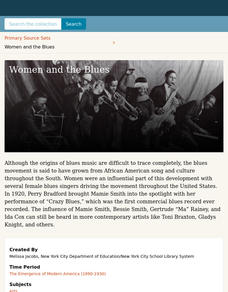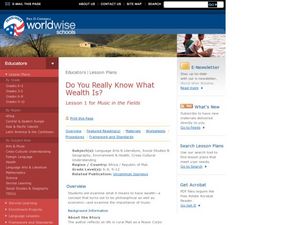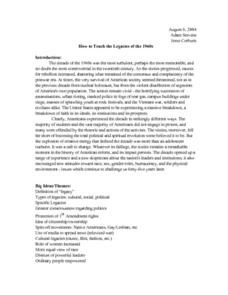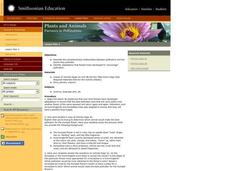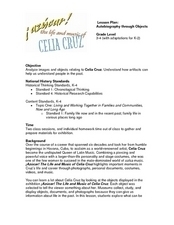Digital Public Library of America
Women and the Blues
A 12-piece primary source packet sets the tone for a study of the role women played in the origins, development, and impact of blues music. Legends like Bessie Smith, Gertrude "Ma" Rainey, Mamie Smith, and Ida Cox are featured, as are...
Curated OER
A Study Guide for The Phantom of the Opera
Immerse yourself in the beautiful, twisted world of Andrew Lloyd Webber's The Phantom of the Opera. A detailed lesson plan provides important details about the writing, stagecraft, music, and literary elements of the famous musical,...
National Woman's History Museum
Songs of Protest: Seneca Falls to Vietnam
Long before the songs of the 1960's Peace Movement, long before the songs of the Civil Rights Movement, and even before the songs of the Abolition Movement, were the songs of the Suffrage Movement. To understand the power of protest...
Digital Public Library of America
Their Eyes Were Watching God by Zora Neale Hurston
Zora Neale Hurston's novel Their eyes Were Watching God has been highly praised and severely criticized for its depiction of African American folk culture. A set of primary source materials, including photographs, articles, essays, and...
Curated OER
200 Greatest Pop Culture Icons
Upper graders explore pop culture and pop music as a forum for female role models. They explore women who have currently contributed to our pop world and why they could be considered role models. They each interview a woman in their...
Curated OER
VH1 100 Greatest Women of Rock & Roll Lesson 5
Students analyze female artists who work in the genres of rock and roll, and alternative rock music. They complete an information sheet on biographical information.
Curated OER
VH1 100 Greatest Women of Rock & Roll Lesson 1
Young scholars the influence of women's music in history and the suffrage movement.
Curated OER
An Ancient Greek and Roman Festival
Third graders label a map of ancient Greek and Roman civilizations and do a written report on one element of these two cultures. They participate in discussions of food, farming, daily life and government (among others). Students use the...
Curated OER
Say It Loud!: A Celebration Of Black Music In America Music In America
Students study early New Orleans Jazz music and recognize Louis Armstrong as an early jazz artist. They recognize the elements and roots of Jazz.
Curated OER
Women in Jazz
Students watch a video: "VH1 Millennium Jazz Festival From The White House" to become familiar with prominent women in jazz. They discuss the vocally oriented nature of jazz and the contributions made by women on and off stage.
Annenberg Foundation
Egalitarian America
What does a true American represent? Scholars investigate the equal rights era of the 1960s and 1970s in the 20th installment of a 22-part series on American history. Using photographic, magazine, written, and video evidence, groups...
Curated OER
Do You Really Know What Wealth Is?
Students explore what it means to have wealth in Mali and in the United States. In this economics lesson plan, students read "Music in the Fields." Student groups answer discussion questions. Students reflect on the purpose music...
Penguin Books
Up Close: Ella Fitzgerald
A reading of Tanya Lee Stones' biography of Ella Fitzgerald lets middle schoolers get up close and personal with the First Lady of Jazz. Stone recounts details of Fitzgerald's life from her early days through her experiences as a teenage...
Curated OER
Modern Minstrelsy: Exploring Racist Stereotypes in Literature and Life
Satires may be designed to expose a bias to ridicule but if misunderstood can they reinforce that bias? Langston Hughes poem, “Minstrel Man” opens a discussion of racist stereotypes, the minstrel tradition, and the musical, “The...
Film Space
Whale Rider
Ready for an educational movie day? Use a resource based on the movie Whale Rider to learn more about the Maori culture. Class members answer a variety of questions and listen to music from the soundtrack to further analyze and...
Curated OER
Listen Up: Antigone Rising
Upper graders listen to and watch a documentary about an all female group Antigone Rising. They discuss how females are portrayed in the rock world, the type of music they play, their song lyrics, and what they note in the documentary....
Curated OER
How to Teach the Legacies of the 1960s
High schoolers consider which aspects of world around them have roots in 1960s, research and compare 1960s to today with regards to Civil and Women's Rights, Vietnam, counterculture, music, voting, and economic rights, and explore legacy...
Curated OER
Plants and Animals: Partners in Pollination
Students describe the complementary relationships between pollinators and the plants they pollinate, identify adaptations that flowers have developed to "encourage" pollination, and create and draw their own "designer" flowers.
Curated OER
The Westward Movement
Students study the westward movement through examining stamps. For this westward movement lesson plan, students draw conclusions, determine cause and effect relationships and examine the westward movement of the United States by...
Smithsonian Institution
Autobiography through Objects
Show youngsters how objects can tell a story! Here your class will learn about Cuban salsa dancer Celia Cruz by analyzing pictures of her dress, her shoes, and her marriage certificate. After describing Cruz's items and imagining what...
Curated OER
JAPAN, IMAGES A PEOPLE
Students interpret Japanese and American paintings; evaluate paintings as sources of cultural and historical information
Curated OER
How Things Fly
Students, by drawing on their own experiences, discuss and examine the basic physics of flight. They participate in a variety of activities regarding flight.
Curated OER
Being in the Noh: An Introduction to Japanese Noh Plays
Students analyze the conventions used in Noh plays and write an introduction to a Noh play of their own. In this Noh play lesson, students identify the conventions of the Noh form and analyze the realizations the main character achieves....
Curated OER
The Sound and Feel of the 1920s
Eleventh graders comprehend the 1920's. They analyze examples of art from 1920's to build an comprehension of the times. They are asked if art reflect or transcend the time in which it was created? Students discuss the common element...
